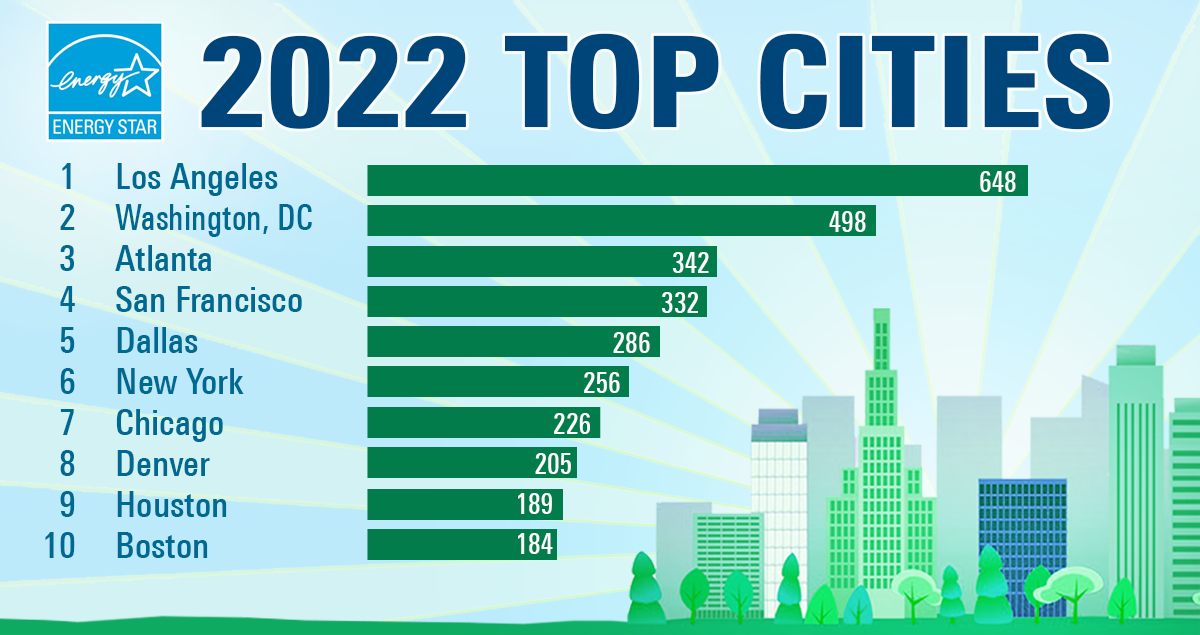The U.S. Environmental Protection Agency (EPA) has revealed its 2022 ENERGY STAR “Top Cities” list, spotlighting the cities with the greatest number of ENERGY STAR certified commercial and multifamily buildings in 2021. Los Angeles leads with nearly 650 ENERGY STAR certified buildings. Close behind is Washington, DC with nearly 500 buildings, followed by Atlanta in third place. Orlando makes its debut on this year’s list, ranking in 24th place with 54 ENERGY STAR certified buildings.
“Right now, our cities and urban areas are experiencing the costly impacts of climate change, but there are steps we can take to reduce emissions and tackle this crisis,” said EPA Administrator Michael S. Regan. “Working with EPA, the owners and managers of ENERGY STAR certified buildings are taking concrete actions that will reduce emissions, save on their energy bills, and help protect their cities for the future.”

Commercial buildings are responsible for 18% of the nation’s energy use and spend more than $190 billion per year on energy bills. ENERGY STAR certified buildings use an average of 35% less energy and are responsible for 35% less carbon dioxide emissions than typical buildings.
First released in 2009, EPA’s list of cities with the most ENERGY STAR certified buildings shows how buildings across America are embracing energy efficiency as a simple and effective way to save money and reduce greenhouse gas emissions. To create the annual list, EPA tallies the number of ENERGY STAR certified buildings within each metropolitan area, as defined by the U.S. Census, and creates separate rankings for mid-sized and small cities. These areas include the city itself as well as surrounding suburbs. This year’s list includes buildings that earned EPA’s ENERGY STAR during the year 2021.
2022 Top 25 Cities Overall | |||
Rank | Metro Area | Building Count | |
1 | Los Angeles | 648 | |
2 | Washington, DC | 498 | |
3 | Atlanta | 342 | |
4 | San Francisco | 332 | |
5 | Dallas | 286 | |
6 | New York | 256 | |
7 | Chicago | 226 | |
8 | Denver | 205 | |
9 | Houston | 189 | |
10 | Boston | 184 | |
11 | San Diego | 161 | |
12 | Austin | 147 | |
13 | Seattle | 138 | |
14 | Minneapolis | 130 | |
15 | Tampa | 118 | |
16 | Phoenix | 116 | |
16 | San Jose | 116 | |
18 | Riverside | 96 | |
19 | Charlotte | 92 | |
20 | Miami | 79 | |
21 | Provo, UT | 75 | |
22 | Philadelphia | 73 | |
23 | Sacramento | 62 | |
24 | Orlando | 54 | |
25 | Cincinnati | 53 | |
Top 10 Mid-Sized Cities | |||
Rank | Metro Area | Building Count | |
1 | San Jose, CA | 116 | |
2 | Provo, UT | 75 | |
3 | Raleigh, NC | 51 | |
4 | Louisville, KY | 35 | |
5 | Sioux Falls, SD | 32 | |
6 | Boulder, CO | 31 | |
7 | Macon, GA | 30 | |
8 | Salt Lake City, UT | 26 | |
9 | Des Moines, IA | 25 | |
10 | Madison, WI | 22 | |
Top 10 Small Cities | |||
Rank | Metro Area | Building Count | |
1 | Jackson, MI | 38 | |
2 | San Angelo, TX | 23 | |
3 | Sioux City, IA | 16 | |
4 | Elizabethtown, KY | 10 | |
4 | Carson City, NV | 10 | |
6 | California, MD | 4 | |
7 | Parkersburg, WV | 3 | |
7 | Bowling Green, KY | 3 | |
7 | Wheeling, WV | 3 | |
7 | Saginaw, MI | 3 | |
| 7 | Oshkosh, WI | 3 | |
| 7 | Salem, OH | 3 | |
| 7 | New Philadelphia, OH | 3 | |
Across the country, more than 6,000 commercial buildings earned the EPA’s ENERGY STAR last year.
As of the end of 2021, over 39,000 buildings across America have earned ENERGY STAR certification. Together, these buildings have saved more than $5 billion on energy bills and prevented nearly 22 million metric tons of greenhouse gas emissions — equal to the annual emissions of more than 2.7 million homes.
To earn the ENERGY STAR, a commercial building must achieve an ENERGY STAR score of 75 or higher on EPA’s 1 – 100 scale, indicating that it is more energy efficient than 75% of similar buildings nationwide. A building’s ENERGY STAR score is calculated based on a number of factors, including energy use, hours of operation, and a variety of other operating characteristics.
Throughout the Covid-19 pandemic in 2021, building owners and managers relied on the ENERGY STAR score to maintain a clear picture of their buildings’ energy performance, despite major changes to their operations. While many office buildings, schools, and retail stores saw significant reductions in occupancy, most hospitals and multifamily buildings were more heavily used. The ENERGY STAR score took these changes into account and continued to provide an accurate assessment of performance for all types of buildings.













![[VIDEO] Get More for Your Business in Ardmore. Oklahoma](https://businessfacilities.com/wp-content/uploads/2024/02/maxresdefault-324x160.jpg)
